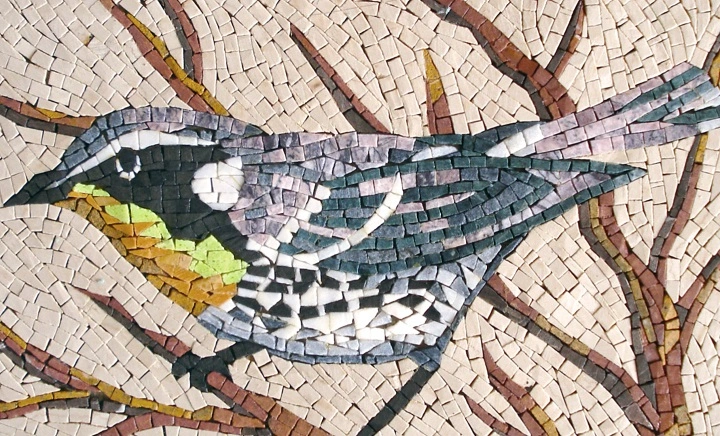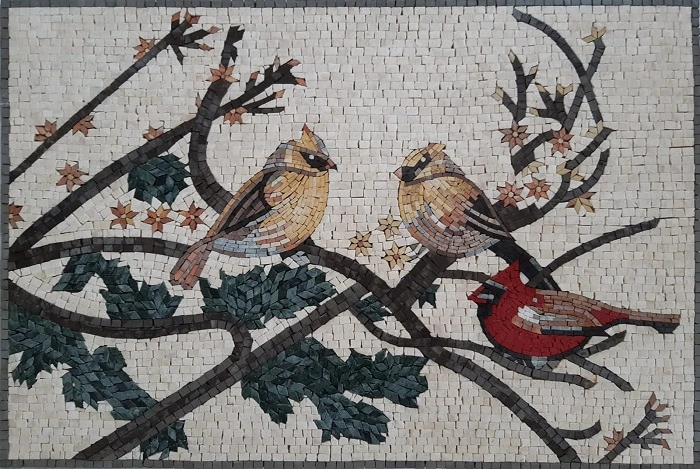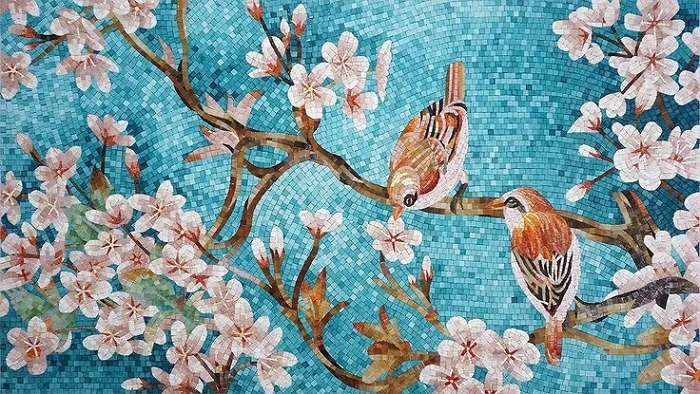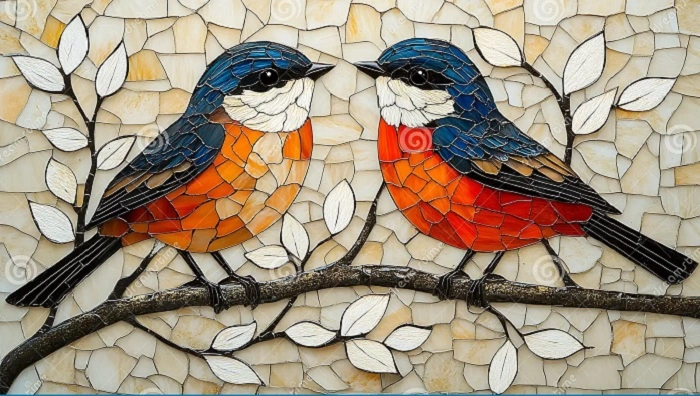Mosaic art, with its rich history and vibrant aesthetic, has captivated artists and enthusiasts for centuries. One of the most striking and beautiful ways mosaic art is used is in the portrayal of birds. Mosaic birds combine the intricate technique of creating designs with small pieces of material and the natural beauty of avian life, resulting in stunning works of art. In this blog post, we’ll explore the fascinating world of mosaic birds, their artistic origins, the techniques used to create them, and how they continue to inspire both art lovers and bird enthusiasts today.
The Origins of Mosaic Art
What is Mosaic Art?
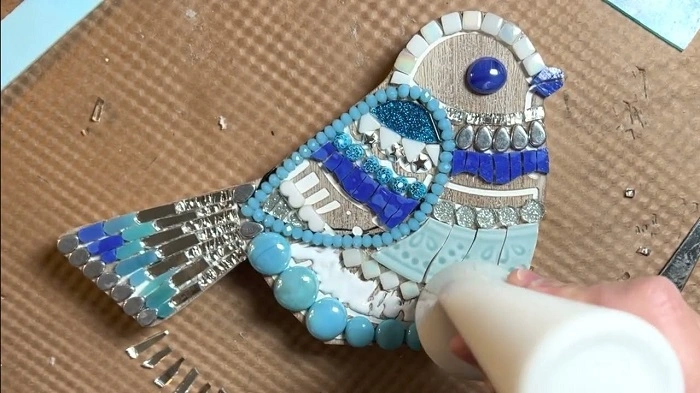
Mosaic art involves creating images or patterns by assembling small pieces of colored materials such as glass, stone, ceramic, or even shells. These pieces, known as tesserae, are arranged in such a way that they form a cohesive and visually appealing design when viewed from a distance. Mosaics date back thousands of years, with early examples found in ancient Mesopotamia, Greece, and Rome. Over time, mosaic techniques evolved and spread across the world, influencing both architectural designs and standalone artwork.
While mosaics were initially used in religious and public spaces, they eventually found their way into private homes and more decorative settings. Today, mosaic art is appreciated for its versatility and its ability to transform any space, adding texture, color, and depth.
Mosaics and Birds: A Perfect Combination
Birds have been a frequent subject in mosaic art due to their beauty, symbolism, and cultural significance. From the ancient Egyptians to contemporary artists, birds have been used to symbolize freedom, peace, love, and the connection between heaven and earth. Their vibrant colors and intricate feather patterns make them an ideal subject for the detailed and colorful medium of mosaics.
Mosaic birds have a timeless appeal, as they bring together the natural world with artistic craftsmanship. Whether created as wall art, decorative pieces, or installations, mosaic birds continue to captivate viewers with their vibrant, lifelike representations of avian life.
The Techniques of Creating Mosaic Birds
Materials Used in Mosaic Bird Art
The materials used to create mosaic birds vary depending on the artist’s preferences and the intended effect. Here are some of the most common materials used:
- Glass: Colored glass tesserae are a popular choice for mosaics because of their luminous quality and ability to reflect light. Glass can be cut into small squares or custom shapes to form intricate feather patterns in bird designs.
- Ceramic Tiles: Broken ceramic tiles are often used for creating mosaics, offering a wide range of colors and textures. Their uneven edges can give mosaic birds a more organic, rustic appearance.
- Stone: For a more natural or earthy feel, stone tesserae are often used. These can include marble, slate, or pebbles, and can help create a more grounded and realistic depiction of birds.
- Smalti: Smalti is a special type of glass used in mosaic art, often favored for its rich, opaque colors and durability. It is especially useful for creating vibrant, detailed images of birds.
- Beads and Gems: Some mosaic artists incorporate small beads or gemstones into their designs for added sparkle and texture, bringing an extra layer of dimension to the bird figures.
Techniques of Mosaic Bird Creation
Creating mosaic birds requires a high level of skill and patience, as each piece must be carefully placed to form the desired shape and color. Here’s a simplified version of the typical process:
- Design Creation: The artist begins by sketching the design of the bird, whether it’s a simple profile or a more complex scene with multiple birds. The design will serve as a template for laying out the tesserae.
- Cutting the Tesserae: Using tools like tile cutters or glass cutters, the artist cuts the chosen materials into small pieces. These pieces can vary in shape, but they are typically square, rectangular, or irregular.
- Arranging the Tesserae: The artist arranges the tesserae on a surface according to the design, ensuring that the colors and textures are used strategically to mimic the bird’s feathers, wings, and other features.
- Adhering the Tesserae: Once the tesserae are arranged, they are glued onto a backing surface. The artist may work in sections to ensure precision.
- Grouting and Finishing Touches: After the tesserae are in place, grout is applied to fill the spaces between the pieces. Once the grout dries, the piece is cleaned, and any final touches are made to ensure that the bird’s features pop.
The Artistic Vision Behind Mosaic Birds
Mosaic artists often choose birds as subjects because of their symbolic value and the opportunity to experiment with a range of vibrant colors. The complexity of feathers, the gracefulness of flight, and the variety of bird species provide endless possibilities for creative expression. For example, an artist might focus on the elegance of a peacock’s plumage, the vibrancy of a tropical bird, or the simplicity of a soaring eagle. The use of color, texture, and form in mosaic art can bring a bird to life in ways that few other mediums can match.
Types of Mosaic Birds
Tropical Birds
Tropical birds such as parrots, toucans, and macaws are popular subjects for mosaic art due to their striking and colorful plumage. The bright colors of these birds, especially their vibrant greens, reds, yellows, and blues, translate beautifully into mosaic form. These birds can often be found in large, dynamic pieces that emphasize the beauty and vibrancy of the tropical rainforest.
Birds of Prey
Birds of prey, such as eagles, hawks, and owls, are another popular subject in mosaic art. These birds, known for their power and grace, can be depicted in dramatic, motion-filled poses. Their sharp features, powerful wings, and intense gaze make them perfect subjects for mosaics, where every detail can be captured with precision.
Songbirds
Songbirds, with their delicate features and gentle colors, lend themselves well to smaller, more intimate mosaic pieces. Birds such as robins, sparrows, and finches are often depicted perched on branches or in flight. These mosaics can be used to create serene and calming atmospheres, often highlighting the beauty of the birds’ natural surroundings.
Waterfowl
Waterfowl like ducks, swans, and geese are often featured in mosaics because of their graceful, flowing forms and elegant features. Artists might depict waterfowl on a serene lake or in flight over a body of water, using the reflective qualities of the mosaic materials to capture the ripples of water and the birds’ movements.
The Appeal of Mosaic Birds in Modern Art
Mosaic Birds as Home Décor
Mosaic birds have found a special place in home décor, particularly for those who appreciate the combination of nature and art. Whether hanging as large wall pieces or displayed as smaller decorative items, mosaic birds add a colorful and natural element to a room. They can also be used in outdoor settings, such as garden installations or as part of decorative birdbaths and sculptures.
Unique Custom Pieces
Mosaic bird art offers a unique and personalized touch for collectors. Artists can create custom mosaics based on specific bird species or personal preferences. These one-of-a-kind pieces are often cherished as heirlooms or as personal tributes to favorite birds or birds encountered in nature.
The Enduring Popularity of Mosaic Birds
Mosaic birds continue to captivate audiences with their beauty and intricate craftsmanship. They appeal to those who love both nature and art, blending the two in a way that celebrates the vibrancy of the avian world. Whether in the form of a small decorative piece or a grand installation, mosaic birds will continue to inspire admiration for their delicate, colorful beauty.
FAQs About Mosaic Birds
What materials are commonly used in creating mosaic birds?
Common materials for mosaic birds include glass, ceramic tiles, stone, smalti, and beads, which are chosen for their color and texture.
Are mosaic birds suitable for outdoor use?
Yes, mosaic birds can be used outdoors, especially in garden installations or decorative sculptures. However, outdoor mosaics should be made with weather-resistant materials to ensure durability.
How are mosaic birds made?
Mosaic birds are created by cutting tesserae into small pieces, arranging them on a surface to form a bird design, gluing them in place, and then applying grout to fill the gaps between the pieces.
What makes mosaic birds so popular?
Mosaic birds are popular because they combine vibrant colors, intricate detail, and the beauty of nature. They make stunning decorative pieces for homes and gardens.
Can mosaic birds be customized?
Yes, artists can create custom mosaic birds based on specific bird species or personal preferences, making them unique and personal pieces of art.
Mosaic birds are an enchanting way to celebrate the beauty of avian life through art. From their rich history to the intricate techniques involved in their creation, mosaic birds continue to be a beloved art form for those who appreciate both nature and craftsmanship. Whether as a decorative piece in a home or a striking installation in a garden, mosaic birds remain timeless symbols of color, life, and artistic expression.


